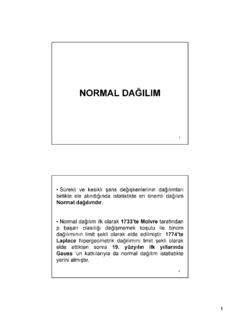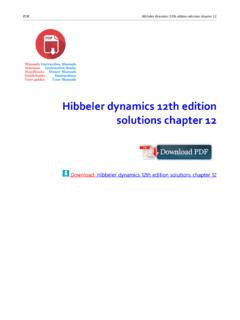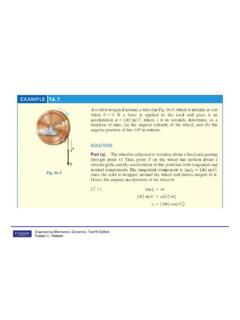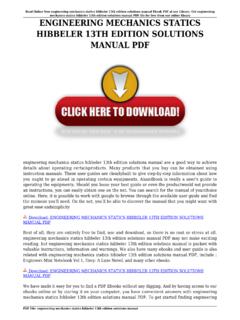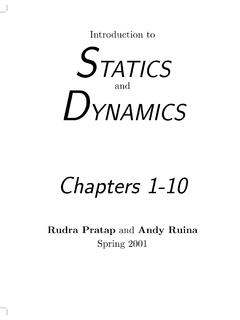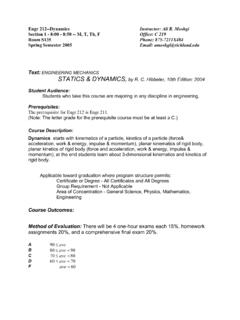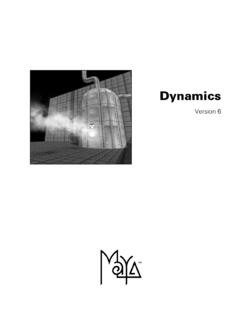Transcription of CHAP12 Kinetics of particles Newtons2Law - DEU
1 VECTOR MECHANICS FOR ENGINEERS:DYNAMICSE ighth EditionFerdinand P. BeerE. Russell Johnston, Notes:J. Walt OlerTexas Tech UniversityCHAPTER 2007 The McGraw-Hill Companies, Inc. All rights reserved. 12 Kinetics of particles : Newton s Second Law 2007 The McGraw-Hill Companies, Inc. All rights reserved. Vector Mechanics for Engineers: DynamicsEighthEdition12 - 2 ContentsIntroductionNewton s Second Law of MotionLinear Momentum of a ParticleSystems of UnitsEquations of MotionDynamic EquilibriumSample Problem Problem Problem Problem Problem Momentum of a ParticleEquations of Motion in Radial & Transverse ComponentsConservation of Angular MomentumNewton s Law of GravitationSample Problem Problem of a Particle Under a Central ForceApplication to Space MechanicsSample Problem s Laws of Planetary Motion 2007 The McGraw-Hill Companies, Inc. All rights reserved.
2 Vector Mechanics for Engineers: DynamicsEighthEdition12 - 3 Introduction Newton s first and third laws are sufficient for the study of bodies at rest (statics) or bodies in motion with no acceleration. When a body accelerates (changes in velocity magnitude or direction), Newton s second law is required to relate the motion of the body to the forces acting on it. Newton s second law:- A particle will have an acceleration proportional to the magnitude of the resultant force acting on it and in the direction of the resultant The resultant of the forces acting on a particle is equal to the rate of change of linear momentum of the The sum of the moments about Oof the forces acting on a particle is equal to the rate of change of angular momentum of the particle about O. 2007 The McGraw-Hill Companies, Inc. All rights reserved. Vector Mechanics for Engineers: DynamicsEighthEdition12 - 4 Newton s Second Law of Motion Newton s Second Law: If the resultant forceacting on a particle is not zero, the particle will have an acceleration proportional to the magnitude of resultantand in the direction of the resultant.
3 Consider a particle subjected to constant forces,maFaFaF mass,constant332211===== When a particle of mass mis acted upon by a force the acceleration of the particle must satisfy,F amF = Acceleration must be evaluated with respect to a Newtonian frame of reference, , one that is not accelerating or rotating. If force acting on particle is zero, particle will not accelerate, , it will remain stationary or continue on a straight line at constant velocity. 2007 The McGraw-Hill Companies, Inc. All rights reserved. Vector Mechanics for Engineers: DynamicsEighthEdition12 - 5 Linear Momentum of a Particle Replacing the acceleration by the derivative of the velocity yields()particle theof momentumlinear ==== LdtLdvmdtddtvdmF Linear Momentum Conservation Principle: If the resultant force on a particle is zero, the linear momentum of the particle remains constant in both magnitude and direction.
4 2007 The McGraw-Hill Companies, Inc. All rights reserved. Vector Mechanics for Engineers: DynamicsEighthEdition12 - 6 Systems of Units Of the units for the four primary dimensions (force, mass, length, and time), three may be chosen arbitrarily. The fourth must be compatible with Newton s 2nd Law. International System of Units(SI Units): base units are the units of length (m), mass (kg), and time (second). The unit of force is derived,()22smkg1sm1kg1N1 = = US customary units these units are, respectively the foot (ft), the pound (lb) and second (s) 1 foot = m1 lb = kgg = ft/s2= m/s2 The unit of mass is derived,221lblb s1slug11ft sft == 2007 The McGraw-Hill Companies, Inc. All rights reserved. Vector Mechanics for Engineers: DynamicsEighthEdition12 - 7 Equations of Motion Newton s second law providesamF = Solution for particle motion is facilitated by resolving vector equation into scalar component equations, , for rectangular components,()()zmFymFxmFmaFmaFmaFkajaiam kFjFiFzyxzzyyxxzyxzyx ======++=++ For tangential and normal components, 2vmFdtdvmFmaFmaFntnntt==== 2007 The McGraw-Hill Companies, Inc.
5 All rights reserved. Vector Mechanics for Engineers: DynamicsEighthEdition12 - 8 Dynamic Equilibrium Alternate expression of Newton s second law,ectorinertial vamamF 0 = With the inclusion of the inertial vector, the system of forces acting on the particle is equivalent to zero. The particle is in dynamic equilibrium. Methods developed for particles in static equilibrium may be applied, , coplanar forces may be represented with a closed vector polygon. Inertia vectors are often called inertial forcesas they measure the resistance that particles offer to changes in motion, , changes in speed or direction. Inertial forces may be conceptually useful but are not like the contact and gravitational forces found in statics. 2007 The McGraw-Hill Companies, Inc. All rights reserved. Vector Mechanics for Engineers: DynamicsEighthEdition12 - 9 Sample Problem kg block rests on a horizontal plane.
6 Find the magnitude of the force Prequired to give the block an accelera-tion or 3 m/s2 to the right. The coef-ficient of kinetic friction between the block and plane is k= : Resolve the equation of motion for the block into two rectangular component equations. Unknowns consist of the applied force Pand the normal reaction Nfrom the plane. The two equations may be solved for these unknowns. 2007 The McGraw-Hill Companies, Inc. All rights reserved. Vector Mechanics for Engineers: DynamicsEighthEdition12 - 10 Sample Problem 890mgW==== xyOSOLUTION: Resolve the equation of motion for the block into two rectangular component equations.:maFx= ()() RP:0= yF0N89030sin= PR Unknowns consist of the applied force Pand the normal reaction Nfrom the plane. The two equations may be solved for these unknowns.() + + = 2007 The McGraw-Hill Companies, Inc.
7 All rights reserved. Vector Mechanics for Engineers: DynamicsEighthEdition12 - 11 Sample Problem two blocks shown start from rest. The horizontal plane and the pulley are frictionless, and the pulley is assumed to be of negligible mass. Determine the acceleration of each block and the tension in the : Write the kinematic relationships for the dependent motions and accelerations of the blocks. Write the equations of motion for the blocks and pulley. Combine the kinematic relationships with the equations of motion to solve for the accelerations and cord tension. 2007 The McGraw-Hill Companies, Inc. All rights reserved. Vector Mechanics for Engineers: DynamicsEighthEdition12 - 12 Sample Problem Write equations of motion for blocks and pulley.:AAxamF= ()AaTkg1001=:BByamF= ()()()() = :0== CCyamF0212= TTSOLUTION: Write the kinematic relationships for the dependent motions and accelerations of the 2007 The McGraw-Hill Companies, Inc.
8 All rights reserved. Vector Mechanics for Engineers: DynamicsEighthEdition12 - 13 Sample Problem () Combine kinematic relationships with equations of motion to solve for accelerations and cord ()AaTkg1001=()()()ABaaT212kg300-N2940kg3 00-N2940==()()0kg1002kg150N29400212= = AAaaTTxyO 2007 The McGraw-Hill Companies, Inc. All rights reserved. Vector Mechanics for Engineers: DynamicsEighthEdition12 - 14 Sample Problem kg block Bstarts from rest and slides on the kg wedge A, which is supported by a horizontal surface. Neglecting friction, determine (a)the acceleration of the wedge, and (b)the acceleration of the block relative to the : The block is constrained to slide down the wedge. Therefore, their motions are dependent. Express the acceleration of block as the acceleration of wedge plus the acceleration of the block relative to the wedge. Write the equations of motion for the wedge and block.
9 Solve for the accelerations. 2007 The McGraw-Hill Companies, Inc. All rights reserved. Vector Mechanics for Engineers: DynamicsEighthEdition12 - 15 Sample Problem : The block is constrained to slide down the wedge. Therefore, their motions are += Write equations of motion for wedge and :AAxamF= ()AAAAagWNamN== ():30cosABABxBxaamamF == ()() + = = 30sin30cos30cos30singaaaagWWAABABABB():3 0sin == AByByamamF() = 30sin30cos1 ABBagWWN 2007 The McGraw-Hill Companies, Inc. All rights reserved. Vector Mechanics for Engineers: DynamicsEighthEdition12 - 16 Sample Problem ()AAagWN= Solve for the ()() + = + = ()()()()() () + = + = = = N5330sin230cos30sin30cos230sin30cos1 ABABAABBAAABBaWWgWaagWWagWagWWNmass of block B mB= kgWeight of block B WB = mBg= 53 Nmass of Wedge A mA= kgWeight of Wedge A WA= mAg= N 2007 The McGraw-Hill Companies, Inc.
10 All rights reserved. Vector Mechanics for Engineers: DynamicsEighthEdition12 - 17 Sample Problem bob of a 2-m pendulum describes an arc of a circle in a vertical plane. If the tension in the cord is times the weight of the bob for the position shown, find the velocity and accel-eration of the bob in that : Resolve the equation of motion for the bob into tangential and normal components. Solve the component equations for the normal and tangential accelerations. Solve for the velocity in terms of the normal acceleration. 2007 The McGraw-Hill Companies, Inc. All rights reserved. Vector Mechanics for Engineers: DynamicsEighthEdition12 - 18 Sample Problem : Resolve the equation of motion for the bob into tangential and normal components. Solve the component equations for the normal and tangential accelerations.:ttmaF= == :nnmaF= () == Solve for velocity in terms of normal acceleration.

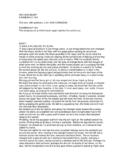

![ÜDS-KPDS-YDS KELME LSTES [SIFATLAR] - …](/cache/preview/f/8/d/f/f/6/a/b/thumb-f8dff6ab9e7282f5c73e3f6e8a7be187.jpg)
